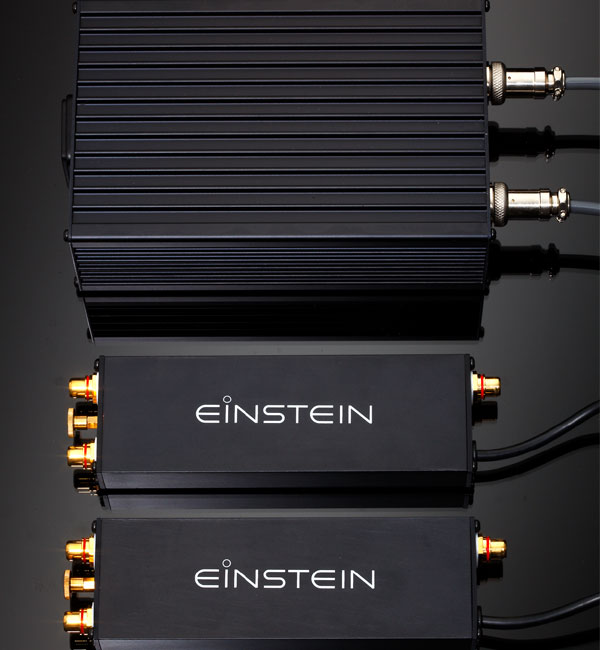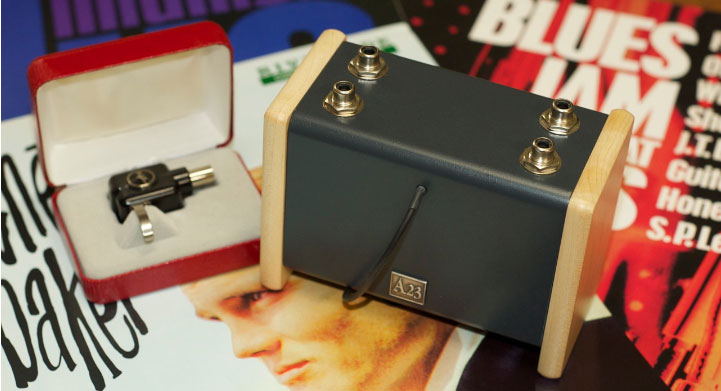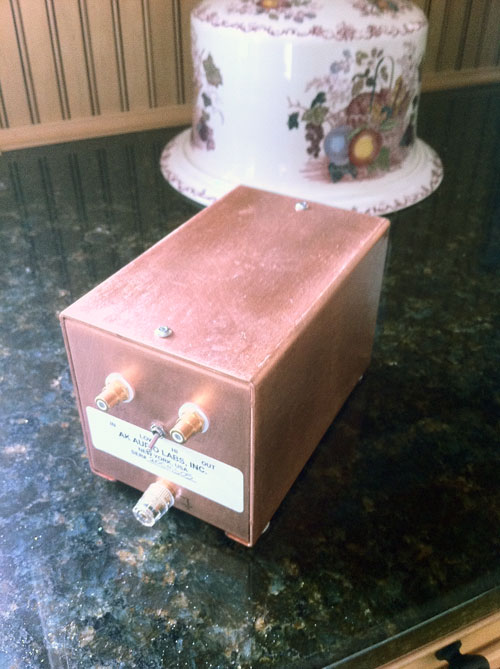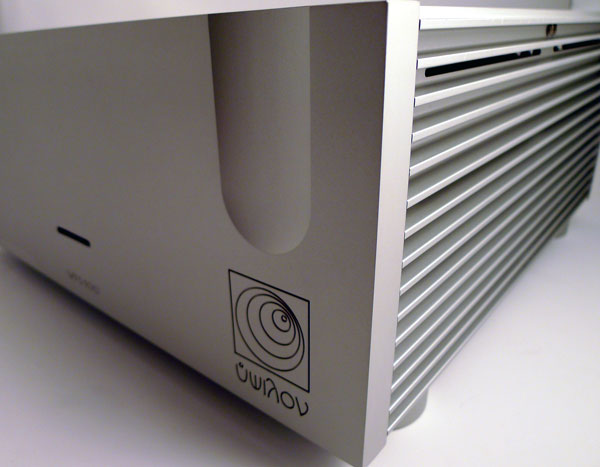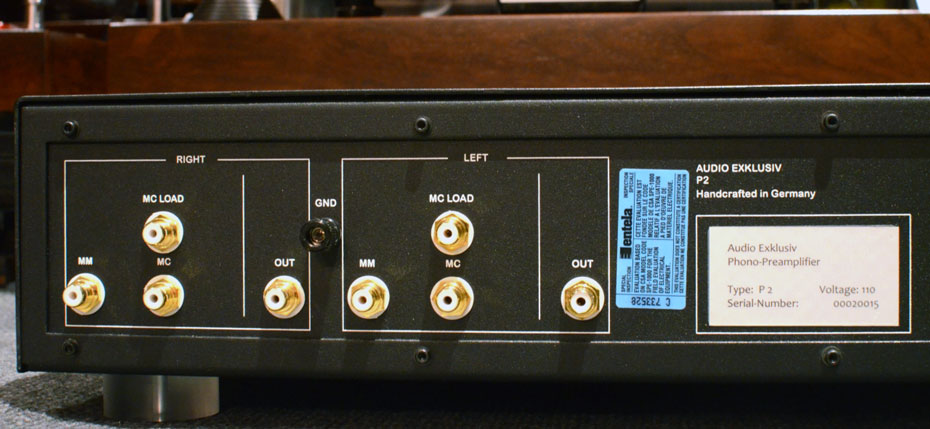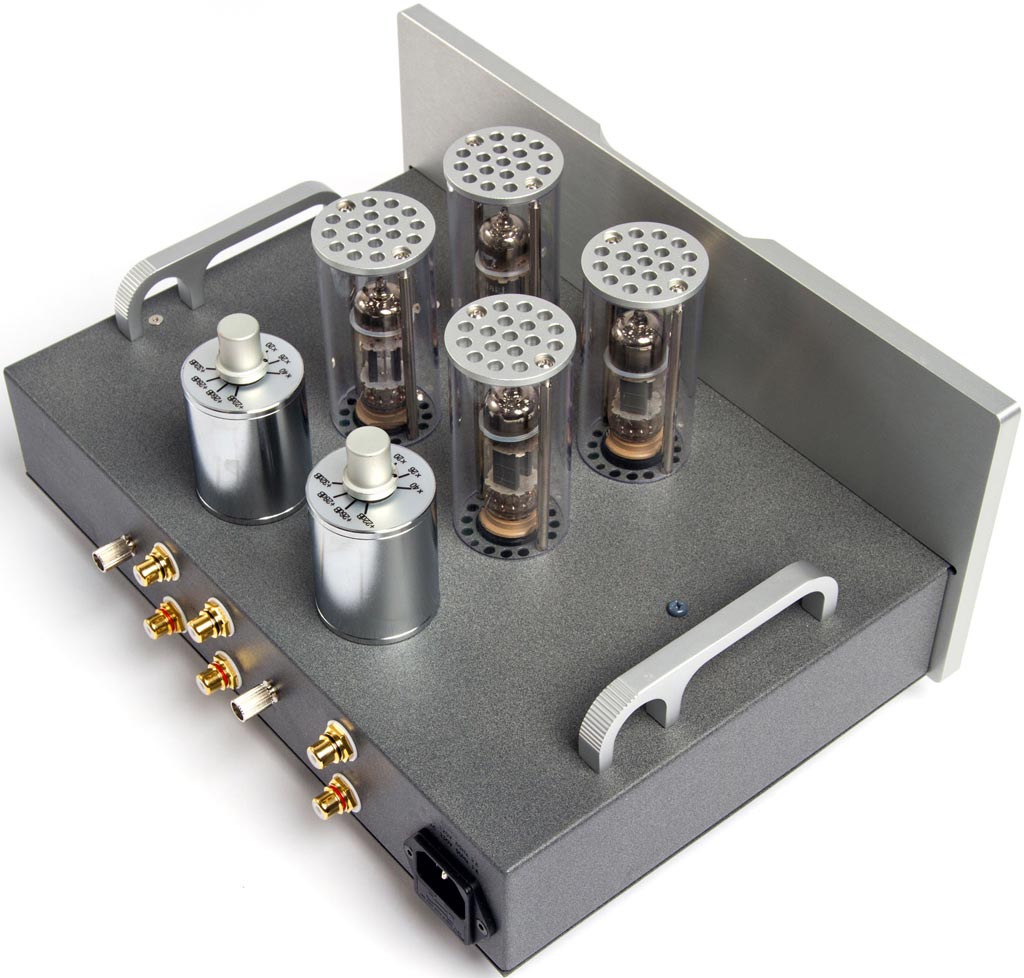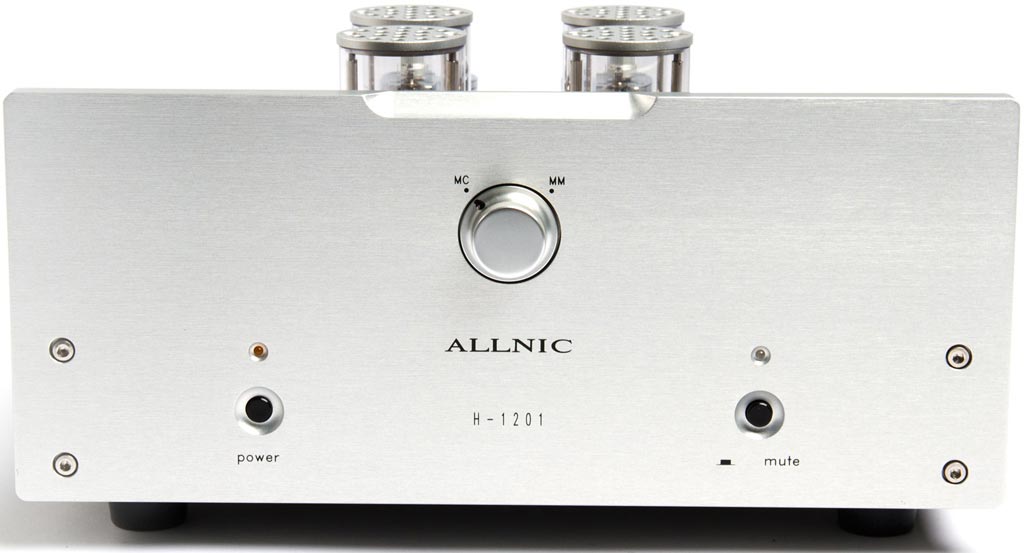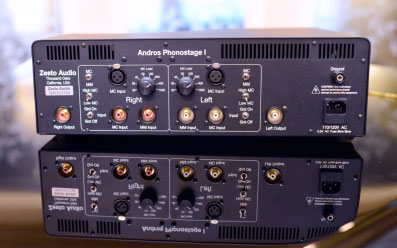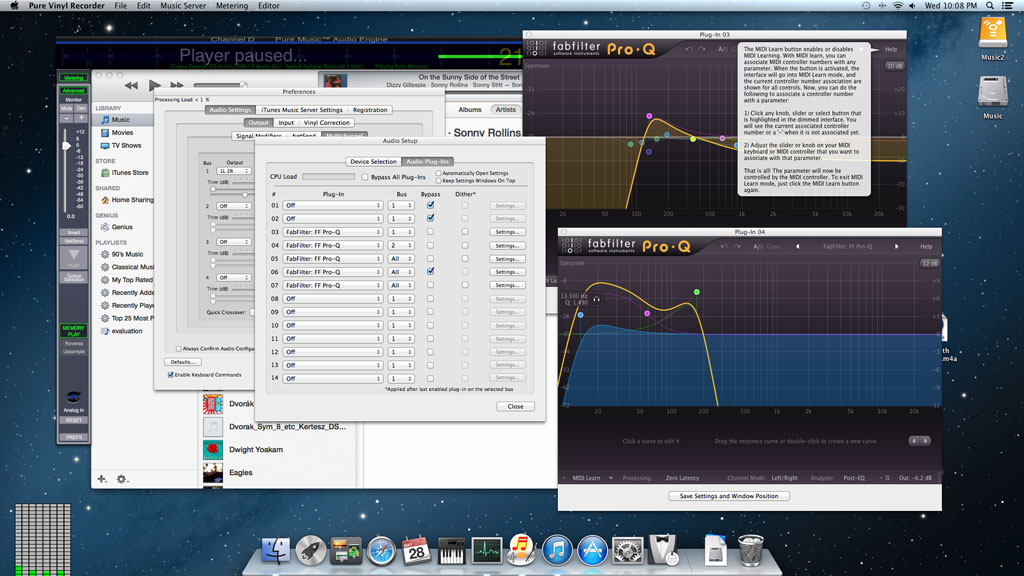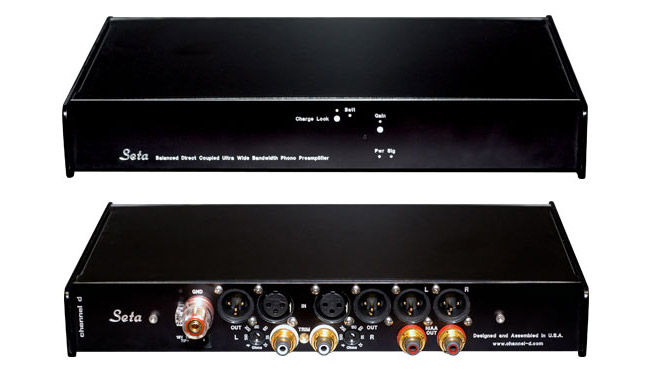![Haniwa HEQA01phono equalizer Haniwa HEQA01phono equalizer]() Extremes
Extremes
I find myself attracted to extremes in music and audio. Stockhausen; Penderecki; a Bach six-part fugue; Tupac, German lied; unaccompanied soloists; brass bands; Coltrane, Ben Webster; Cat Anderson; huge amps and massive panels; tiny DHT amps and single-driver horns; linear trackers; 12” arms; vacuum hold-down; extremely complex; extremely simple. There are truths revealed in musical and technological extremes; these truths are subjective and can’t be proven or disproven. Because we interpret sounds in our brain (we aren’t actually hearing the sound unfiltered) and try to make sense of it, all our life experiences, likes/hates, and prejudices determine how we interpret those sounds. When we go to extremes in music, interpretation, sounds (or anything else), it acts like the refiner’s fire. It brings clarity. There is music that needs triodes and horns; there is music that needs digital (yes, really); there is music that needs power, like when Jeremy Clarkson says “powwwweeerrrrrr….”. It’s difficult to build (or perform) something with state-of-the-art performance in any one area. Rarer still are components that do several things well.
After hearing so many extremes, and hearing what they can reveal, it puts to bed the idea that the huge system or the simple system is the superior approach. If you dig deep, you will usually but not always find that people who have huge systems tend to listen to huge music; and vice versa for the little system. The two systems are appropriate for the music being played. Because I am addicted to records and extremes in music, I have records that won’t get played depending on what kind of system I have assembled at that time. My D2D organ records don’t sound very good on 5-watt tube amps, Lowthers, etc.
The first time I heard one of the AirTight cartridges, I thought to myself that this was an extreme (though in a unique way). It seemed to be cleaner than any other cartridge I had heard up to that point. It combined speed, power and detail with above-average width and depth, but the thing that stood out to me was the vanishingly low distortion. Generally, low distortion comes at a price: the techniques that cancel distortion are oftentimes audible. I’ve talked with a couple of audiophiles who criticized the AirTight as being too Batman-like (kapow; bam; kerboom). I disagree. I think those who find it too fast or zingy, just prefer a more laid back sound, and there is nothing wrong with that. Or, in some cases, the cartridge is overloading their phono stage, overdriving their step-up transformer, putting too much energy into their tonearm, or driving their system into an uncomfortable area. I’ve heard the AirTight cartridges overwhelm a system. Remember “digital ready”? Well, arms and phono stages need an “Airtight (or Mysonic) ready” sticker.
A rose by any other name would smell as sweet
Back in September 2009, I stumbled across a reference to the Haniwa HCTR01, buried in a thread on Audiogon (referencing Stereo Sound’s 2008 rankings of cartridges). I hadn’t heard of Haniwa, so I started to dig for information. Eventually I discovered that it, like the AirTight, was an OEM offering from Mr. Matsudaira’s My Sonic Lab. Matsudaira-San’s audio history is worth noting. He is a Japanese analog to Americans like Henry Kloss, Stu Hegeman, Paul Weathers, Edgar Vilchur, David Hafler, Herb Keros, etc.. I don’t think that’s an overstatement. It’s harder to design and build transducers than amplifiers. By the way, if you don’t know these names, you should, it would be like a baseball fan not knowing who Babe Ruth is. Mr. Matsudaira has developed several different lines, including My Sonic, AirTight and Haniwa. These designs are not just a repackaging of the MySonic cartridges, but designs developed with the input of the engineers at AirTight and Haniwa.
If you think you know the Haniwa because you know the AirTight or MySonic, think again. Matsudaira developed the Haniwa HCTR01 with Renaissance-man, Dr. Tetsuo Kubo, owner/designer/president of Kubotek (Haniwa is a subsidiary of Kubotek). Dr. Kubo had different goals for the Haniwa cartridge; goals that differ significantly from the AirTight and MySonic designs. When I spoke with Dr. Kubo at RMAF ’09, he emphasized that twelve prototypes were built over a period of a few years to perfect what he wanted.
The results of the efforts are truly extreme. When used with the Haniwa phono stage (the subject of an addendum of this review), the cartridge’s VTF is from .6 to 1.0 grams, and when used with most other phono stages, VTF is from 1.0 to 1.5. The compliance is medium-high, closer to a Shure V15 than a DL103. Moving mass has been reduced as much as possible, which makes the high compliance and low tracking force possible. The line-contact stylus is connected to a boron cantilever; the windings have been reduced to such an extent that the output impedance is .8 ohms (eight tenths of one ohm—just so you know I meant what you just read), while still putting out a reasonable .35mV. The “healthy” output is made possible by the powerful magnetic circuit developed by Matsudaira-San. Fewer windings means lower impedance, lower mass, less inductance, better high-frequency extension, and according to Dr. Kubo, much less phase shift than more mundane moving coil offerings.
On paper at least, this is like having your cake and eating it, too. The promise is the tracking of the very best moving magnet, but without the high inductance that screws up high frequencies and phase. Because the Haniwa is a moving coil, it won’t be as affected by cable capacitance as a moving magnet. Looking at it differently, here is a moving coil that doesn’t have a ringing top-end, can track as good as anything, doesn’t chew up records, and doesn’t require the use of some forty-year-old tonearm with crap bearings, crap wiring, and detachable headshell. What it means for me is that there is finally a moving coil that can make the most of my SME V and Mission 774, and all the other low-mass arms that have been assigned 2nd class status because they couldn’t make a Koetsu, Lyra, etc to perform. There are many arms from the ‘70s and ‘80s that were designed for high compliance cartridges, they featured high quality bearings and good build quality, but they were just plain bad with low compliance moving coils.
The Total Experience
Opening the box and examining the contents was like looking at fine jewelry. Just the appearance of this cartridge oozes class, refinement and exclusivity. The paint is gorgeous. The pins look like they were made by a jeweler. The screws are gold plated. The box is closer to one for a pricey wristwatch. Everything is just flawless in presentation.
Mounting the Haniwa is very easy. The body is tapped to accept screws; the only way to go, in my opinion. The fit of the screws and tapped holes has the feel of aviation work. It’s close to a GH2 or GH3 fit, translating into a .001” to .0015” of clearance between screw and tapped hole. I could feel no burrs in the threads or sharp edges on the body. The radiuses on the edges were consistent; the skill required to make a cartridge body this perfect is scarce. The cantilever is protected with a plastic cover during installation. The packaging includes a high quality screwdriver and stylus tip cleaner. There are three sets of screws included. Nothing is left to chance. The plastic part in the shipping box, the part you screw the cartridge to for shipping, is shaped in a way that will prevent you from inadvertently flipping it over and damaging the cartridge. No sharp edges here either. All cartridges should be this easy to mount, should include a stylus guard, include multiple lengths of hardware, and come with foolproof packaging. After setting up 50+ cartridges, you really get aggravated with bad packaging and unfriendly mounting methods. It’s a minor thing to some users, but is evidence that Haniwa is a thoughtful company.
A Sound that matches the Numbers
For the most part, it is difficult to correlate the objective numbers of a product, such as its specifications, to the sound. Not so with the Haniwa. The first thing I noticed was that it tracked difficult records without stress and minimized the effect of vinyl deformations and damage. On passages that had previously elicited distortion from moving coils, the sound of the Haniwa was all calm and peacefulness. Indeed, it tracked like a Shure V15 or one of the top-end Audio-Technica moving magnets. But the Haniwa sounded better: more vivid, more focused, and more saturated. There were instances where the Haniwa coherently played through highly modulated cuts that sounded confused and constrained with other cartridges, MM or MC. The effect was kind of like going from an old pair of monkey coffins (JBL Century L100 comes to mind) to a panel with huge amps (something like Sanders ESL system).
On difficult records, layers of distortion were removed. Grunge was reduced to the point where many records sounded tape-like, although I wouldn’t say that I “rediscovered” my records. The records that are hard to track, ones that generate mistracking and distortion, are relatively few in my collection. I don’t buy records because they sound cool or have audiophile special effects. I buy records for the music. Most discs reproduced similarly as when played by a Lyra, ZYX, or other high quality moving coils. However, there was a cumulative effect of greater ease, more linear frequency response, faster transients, and a more stable image. You’d be struck more by the similarities, than the differences, if you were doing a blind listening test between several high-end moving coils on records of controlled quality. But put in something like The King James Version or some 12” 45rpm dance singles, and you separate the men from the boys, and man, the Haniwa is A MAN of a cartridge.
Because of the extremely low moving mass of the Haniwa, I was able to enjoy some of my old chewed-up mono jazz records with a stereo cartridge (a first). The tics and pops that usually send high-output-moving-coils, aluminum cantilevers, and Deccas among others over the edge, seem to almost be ignored by the Haniwa. You can still hear them: they are there, then they are gone, and they don’t sound like a shotgun blast. Some of the worst sounding cartridges with tics-and-pops are classic high-output moving-coils with aluminum-cantilevers and spherical-tips. All that mass shudders and shimmies after a big scratch. The extra mass of a high output MC moves the resonance frequency of the moving assembly down into a human’s range of hearing. The Haniwa just plowed on through, unfazed by trashed-out vinyl.
The highs of the Haniwa seem purer and more natural than any cartridge I’ve had in my system. Typically, the highs of a moving magnet start to roll off due to inductance. With moving coils, the combination of high mass and stiff suspension drive the resonance frequency down into audibility. The highs of the Haniwa went out into inaudibility without the perturbations or roll-off of many competitors. Something similar in performance is the Soundsmith Sussurro, but the flavor is different; I can’t think of a better word than flavor—sorry.
Where the Haniwa is in rarefied air is its bass authority and tonality that nearly blows everything else out of the water. Except for the strain gauge cartridges, and a few moving magnets, the Haniwa is the absolute baddest-ass bass player on the market. It made my CD player sound puny in comparison. Granted, this bass performance came when used with the Haniwa phono stage; see below. With the Allnic H-1500, it still had amazing bass superiority, but not to the same extent. Where the Haniwa was superior to MM and Soundsmith Strain Gauge was in the way it handled vinyl imperfections and warps. My experiments with strain gauge cartridges were scary when the vinyl had random subsonic garbage. The Haniwa had very little woofer misbehavior with warps, where the Strain Gauge looks like it will launch the woofer into your listening chair.
The only place where the Haniwa wasn’t markedly superior was in imaging. Soundstage width was marvelous, but depth/dimensionality was more down-to-earth, sounding very much like my Lyra or ZYX. It was better than my moving magnets, moving irons and strain gauges. The Haniwa was good, in an absolute way, but not at the level of a handful of cartridges known for layers of depth, like the Koetsu Coralstone; but the Coralstone has more distortion, and is slightly rolled off in comparison to the Haniwa. Both are amazingly good, but being a bit of a flat-earther, my choice is for the Haniwa.
The net result of the Haniwa’s miniscule mass, ultra low impedance, high compliance and useable output voltage is a natural ease that is head and shoulders above many competitors. Good analog tape (2-track at 15ips) is my base-line comparison. The absolute ease in the way the Haniwa presents itself is very much like tape. It compares favorably with the strengths of both high resolution digital and open reel tape.
I’ve had an embarrassing array of cartridges come through the system the last couple years. All have done something good, revealing an alternate truth to experience. All cartridges and speakers will imprint their own peculiar character on the sound. Of the Shures, Audio-Technicas, ZYX R1000 Airy3-X Silver Base & ZN, Lyra (Helikon and Dorian), Haniwa, AirTight, Soundsmith Sussurro, Decca C4e (Expert Stylus rebuild), strain gauge (Panasonic and Win), and ones I’ve heard for shorter periods like the Koetsu Coralstone, Audio Note, Allaerts, and Clearauio, [deep breath] the Haniwa comes closest to the absolute God’s-honest-truth in a cartridge. Not only did every record take on a more distinct personality of its own, but adjustments in VTA, VTF, overhang, and bias were easier to hear and understand.
But wait, there’s more…
Dr. Kubo makes a lot of noise about phase accuracy. If you look at the entire Haniwa product line, phase accuracy is a mantra. The bulk of my listening was done with the Haniwa HEQA01 phono stage. The phase accuracy of the HEQA01 is stated to be +/-1º from 20Hz to 20kHz, and +/- .2 dB accurate frequency response. I don’t have the equipment to test this claim, but the combo definitely sounded as straight and flat as any analog device I’ve used. Particularly startling was the bass performance from the combo. It was the deepest and most powerful I’ve heard, and by quite a bit. It is good enough to challenge the gold standard for analog bass, the strain gauge cartridge. I could hear/feel the size of the hall, the impact of piano hammers, the chest resonance of singers, and the gust of wind that hits the microphone from a wind instrument.
The Haniwa phono stage was designed around, and set at the factory to optimize the tracking and phase accuracy of the Haniwa cartridge. Its loading was 4 ohms, an amazingly low figure. It works because the cartridge is of very low impedance as well. It will also accept a moving magnet with 47kΩ. The unit features a “built-in demagnetizer, which can be activated while the playback, by simply pushing the Degauss Button on the panel, which shunts the circuit to release the core magnetization”. The idea of trying it while listening was too scary for me, so I muted the preamp before degaussing the cartridge. The MC input has 62dB of gain, and the MM has 36dB. Max output is 200mV.
Because I did not have another appropriate moving coil cartridge in the house, I did not use the HEQA01 with another MC, though I did try it with a few moving magnets. The results with the MM were quite good, but not earth shaking. Whatever magic it accomplished with the Haniwa moving coil was not as magical with the high output brethren. I didn’t investigate further. Bottom line is: consider it with ultra low output and low impedance moving coils, as the results were sometimes amazing, and always excellent. The attention paid to phase and frequency response allowed for the most accurate portrayal of overtones I’ve heard from any source, tape included—though I haven’t had a fully tweaked and aligned open-reel machine. From the bottom up, instruments had the most natural timbres I’ve heard outside of live music. It all locked in to create an ideal tonal balance that was true to the master tape, whether it be analog or digital.
At the top, I quoted the .6 grams of tracking force when using the Haniwa cartridge with the Haniwa phono stage. Well, I’ll be damned! A moving coil cartridge that really does track at .6 grams. I couldn’t believe what I was seeing/hearing. No, it wasn’t as good at .6 grams as it was at .9-1.1 grams, but there wasn’t the lack of focus, the jittery quality or the borderline tracking distortion I’ve heard with Shures that proclaimed .75-1.5 grams tracking (set at .75 gram). Part of the puzzle here was the SME V has good bearings, and the suspension of the Haniwa cartridge is electrically damped by the 4 ohm loading in the HEQA01.
Going completely against the established wisdom of the high-end (“high end” and wisdom is as much of an oxymoron as military intelligence), the HEQA01 uses feedback and chips. Shriek! The terror! Actually, negative feedback is applied in the bass, which probably accounts for its power. I’ve never had a problem with split active/passive phono stages. The few I’ve heard had better imaging, bass and frequency response, the stereo width (staging) was as good as I’ve heard. The channel-to-channel matching of transistors/chips/feedback have a way of throwing images way outside of both speakers while holding a good center image. As I’ve already stated, the phase and frequency response, and as a result the order and relative strengths overtones/partials, is as good as I’ve heard from any analog source. I have recently heard a very highly regarded transistor phono stage of top notch build quality (expensive parts, detached power supply, heavy and thick body parts) and it was noticeably bright in comparison to the HEQA01. If you find that you are often saying to yourself “that sure is bright”, then the HEQA01 needs to be on your list. I have a system that is slightly lean and the Haniwa phono stage noticeably improved the tonal balance.
I’d have to listen to the HEQA01 with other cartridges to make any blanket recommendations for its use without the HCTR01. With the Haniwa cartridge, it was a strong performer in almost every category. The pair didn’t have the best depth I’ve heard from other combos, though it was very good in an absolute measure.
A One Night Stand
I got the HCTR01 mounted on the last day I was using the Allnic H1500 II SE Plus phono stage (reviewed last year). For a few tantalizing hours I heard what a superior cartridge design could do with a superior RIAA design. If you read that review, you know I am a true believer of LCR phono stages. I have ingested the Kool-Aid. This pairing was amazing. The depth that I felt was slightly shallow with the HEQA01 was in the neighbor’s yard with the Allnic. The noise floor was lower than any cartridge/phono-stage pairing I’ve heard. It seemed as if my pressings were switched out with better ones. Dynamics and rhythms were the best I’ve heard from vinyl.
It makes me wonder what I’d hear with the Allnic H3000 and Ypsilon VPS-100!?!? Would I give up the ghost? I’ve heard what both of them could do with the top AirTight cartridge, and it redefined what analog can and should sound like. I have started to think of the Haniwa as an “AirTight on steroids” or “Shure V15vxmr that actually sounds as good as the numbers look”. Either way, if you are wanting to hear your records for the first time, you need to investigate the Haniwa cartridge and one of the LCR phono stages. Almost as startling is the all-Haniwa combo, but with a different set of strengths.
Where do we go from Hear, I mean, Here?
Every time I feel like analog has finally hit a wall, and can’t improve appreciably, a new wave of gear hits that seems to redefine what the state-of-the-art is. What I recommend to you would depend on what you want and what equipment you already have. For me, the high compliance of the Haniwa HCTR01 made it the first moving coil cartridge that sounded truly superb with the low mass SME V. Most other moving coils I liked had medium to low compliance and needed a massive arm for best sound. Were I using the higher mass 12” aluminum SME 312, or the 3012, or other medium- to high-mass arm, I might have decided that the Soundsmith Sussurro was the cartridge for me. Already having the SME V made the choice a breeze. I purchased the Haniwa HCTR01 and it takes pride of place in my system. At this level of performance, I can easily recommend both Haniwa pieces, in combination, or as separate pieces having different areas of excellence. They belong at the top of the heap with the new generation of analog gear: gear that is redefining our expectations of vinyl playback.
As an addendum to this review, I will be publishing an interview with Dr. Kubo. His goals and views are as unique as his designs.
The post Haniwa Audio HCTR01 Cartridge and HEQA01 Phono Equalizer Review appeared first on Dagogo.

